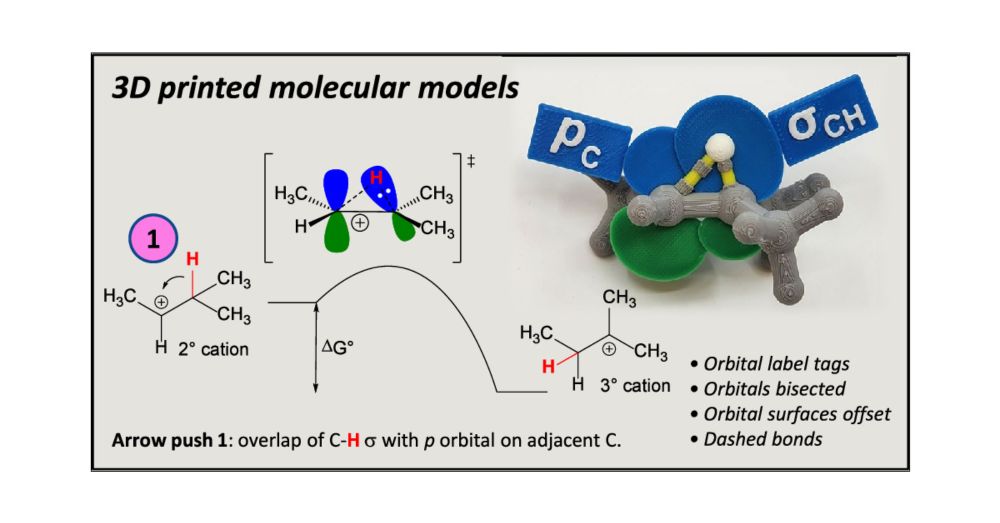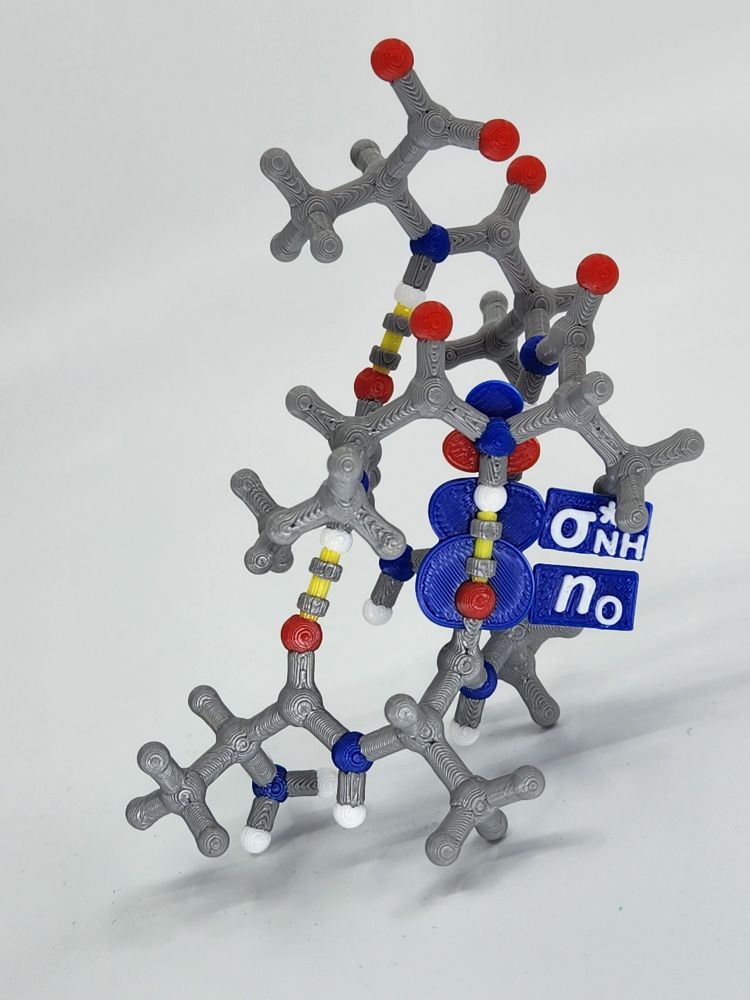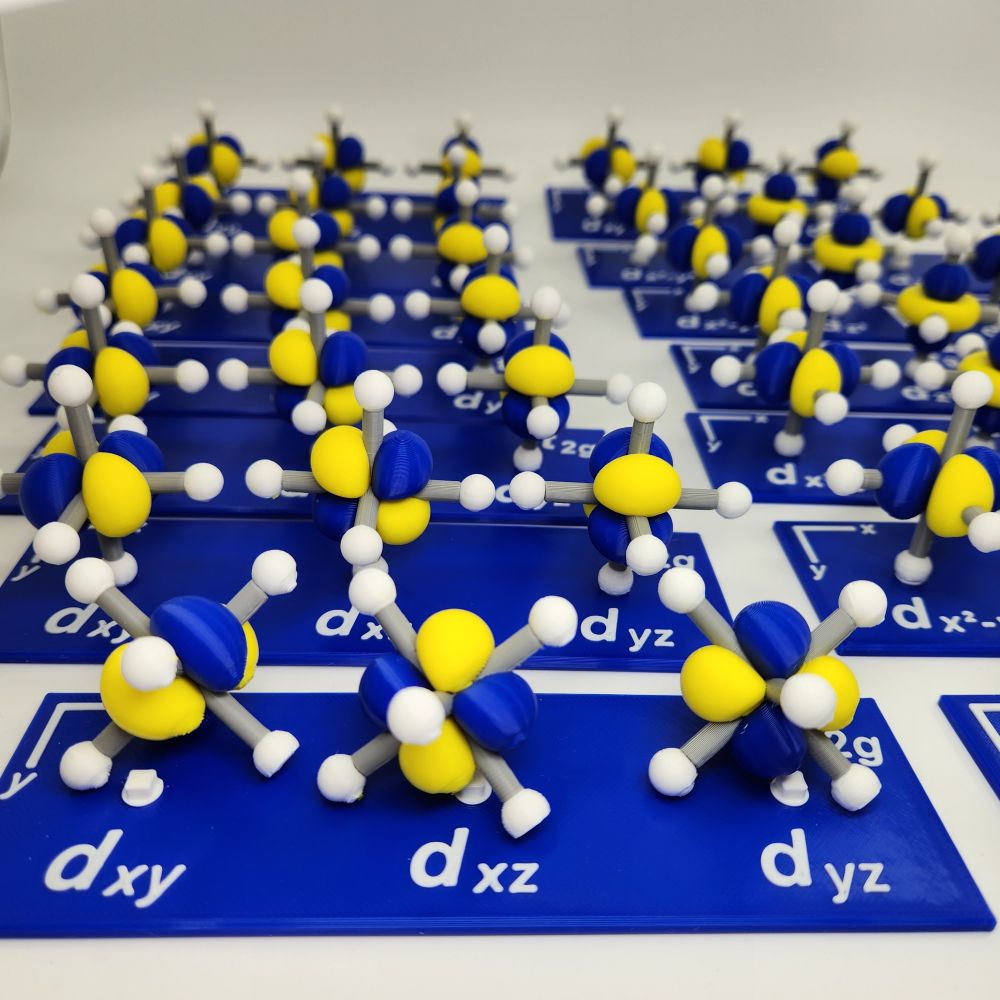Dan O'Leary
@doleary47.bsky.social
330 followers
580 following
44 posts
I'm a professor of chemistry at Pomona College in Claremont, California. I teach general and organic chemistry, NMR spectroscopy, and computational chemistry. My research interests span these realms + the history of science + 3D printing pedagogies.
Posts
Media
Videos
Starter Packs
Pinned
Dan O'Leary
@doleary47.bsky.social
· Jan 24

Multicolor 3D-Printed Molecular Orbital Models for a First-Semester Organic Chemistry Course
We have developed a set of multicolor 3D-printed structural and molecular orbital models for use in a first-semester organic chemistry course. These models provide visual and tactile insights regarding aspects of organic structure, reactivity, and mechanistic “arrow pushing”. The set includes: 1. orbital models of σ and π bonding in methane and ethylene, 2. σCH–σ*CH hyperconjugation in staggered and eclipsed ethane conformations, 3. LUMO accessibility in SN2 electrophiles and HOMO–LUMO orbital interactions in SN2 transition states, 4. E2 transition state structure and orbital interactions in β-hydrogen removal and π bond formation, 5. σCH–pC hyperconjugation in the ethyl cation, 6. transition state structure and σCH–pC orbital interactions in a carbocation 1,2-hydride shift, 7. late and early, respectively, Br• and Cl• H atom radical abstraction transition state structures and SOMO orbitals, 8. bromonium ion structure and LUMO orbital, 9. protonated epoxide ion and neutral epoxide structures and LUMO orbitals, 10. transition state structure and orbital interactions in a hydroboration reaction, 11. transition state structure and orbital interactions in the lithium aluminum hydride reduction of formaldehyde, and 12. π molecular orbitals in 1,3-butadiene. The prints are made with hobby-grade 5-color 3D fused deposition modeling (FDM) printers and sized to provide compact take-home class handouts for each student or projected in-class with a document camera. Models are fabricated with orbital or electron density surface bisections and text annotations to enhance information content. Student perceptions of this set of 3D-printed molecular models are generally favorable and have improved their understanding of course materials.
pubs.acs.org
Dan O'Leary
@doleary47.bsky.social
· May 8
Dan O'Leary
@doleary47.bsky.social
· Apr 19
Dan O'Leary
@doleary47.bsky.social
· Apr 18

Multicolor 3D-Printed Molecular Orbital Models for a First-Semester Organic Chemistry Course
We have developed a set of multicolor 3D-printed structural and molecular orbital models for use in a first-semester organic chemistry course. These models provide visual and tactile insights regarding aspects of organic structure, reactivity, and mechanistic “arrow pushing”. The set includes: 1. orbital models of σ and π bonding in methane and ethylene, 2. σCH–σ*CH hyperconjugation in staggered and eclipsed ethane conformations, 3. LUMO accessibility in SN2 electrophiles and HOMO–LUMO orbital interactions in SN2 transition states, 4. E2 transition state structure and orbital interactions in β-hydrogen removal and π bond formation, 5. σCH–pC hyperconjugation in the ethyl cation, 6. transition state structure and σCH–pC orbital interactions in a carbocation 1,2-hydride shift, 7. late and early, respectively, Br• and Cl• H atom radical abstraction transition state structures and SOMO orbitals, 8. bromonium ion structure and LUMO orbital, 9. protonated epoxide ion and neutral epoxide structures and LUMO orbitals, 10. transition state structure and orbital interactions in a hydroboration reaction, 11. transition state structure and orbital interactions in the lithium aluminum hydride reduction of formaldehyde, and 12. π molecular orbitals in 1,3-butadiene. The prints are made with hobby-grade 5-color 3D fused deposition modeling (FDM) printers and sized to provide compact take-home class handouts for each student or projected in-class with a document camera. Models are fabricated with orbital or electron density surface bisections and text annotations to enhance information content. Student perceptions of this set of 3D-printed molecular models are generally favorable and have improved their understanding of course materials.
pubs.acs.org
Dan O'Leary
@doleary47.bsky.social
· Apr 2
Dan O'Leary
@doleary47.bsky.social
· Apr 2

Do-It-Yourself 5-Color 3D Printing of Molecular Orbitals and Electron Density Surfaces
This report outlines an approach for preparing 5-color 3D printed plastic models of molecular orbitals and electron density surfaces using a hobby-grade 3D printer. Instructions are provided for preparing 3D orbital and electron density surface (EDS) models using solid or mesh representations in ground state and transition state structures. We show that the information content of 3D orbital and surface models can be enhanced with text annotation, bisection, strut and dashed bond placement, and composite orbital-EDS model constructions. Example prints illustrate orbital concepts in organic and inorganic chemistry, such as the ethyl cation (σ–p hyperconjugation), methane (hybridization and C–H bonding), ethane (σ–σ* hyperconjugation in the staggered and eclipsed conformations), 2-hydroxytetrahydropyran (the anomeric effect/n−σ* hyperconjugation), the water dimer (hydrogen bonding/n−σ* overlap), ethylene, 1,3-butadiene, and benzene (π molecular orbitals), Re2Cl82–, and U2(COT)2 (metal–metal quadruple bonds). Transition state models illustrate orbital interactions in the SN2 reaction of cyanide with methyl, ethyl, and isopropyl chloride and in a hydroboration reaction of BH3 with propene. Composite EDS models of methyl and isopropyl chloride (for exploring their relative reactivities as SN2 electrophiles) and methylcyclohexane (visualizing 1,3-diaxial interactions) are described. Student perceptions of a multicolor 3D orbital print used in an introductory organic chemistry laboratory course are reported.
pubs.acs.org
Dan O'Leary
@doleary47.bsky.social
· Mar 31
Dan O'Leary
@doleary47.bsky.social
· Mar 26
Dan O'Leary
@doleary47.bsky.social
· Mar 26
Dan O'Leary
@doleary47.bsky.social
· Mar 26
Dan O'Leary
@doleary47.bsky.social
· Mar 21

Multicolor 3D-Printed Molecular Orbital Models for a First-Semester Organic Chemistry Course
We have developed a set of multicolor 3D-printed structural and molecular orbital models for use in a first-semester organic chemistry course. These models provide visual and tactile insights regardin...
pubs.acs.org
Dan O'Leary
@doleary47.bsky.social
· Mar 21
Dan O'Leary
@doleary47.bsky.social
· Mar 21
Dan O'Leary
@doleary47.bsky.social
· Mar 6

Multicolor 3D-Printed Molecular Orbital Models for a First-Semester Organic Chemistry Course
We have developed a set of multicolor 3D-printed structural and molecular orbital models for use in a first-semester organic chemistry course. These models provide visual and tactile insights regardin...
pubs.acs.org







